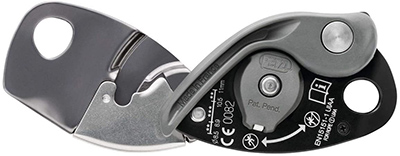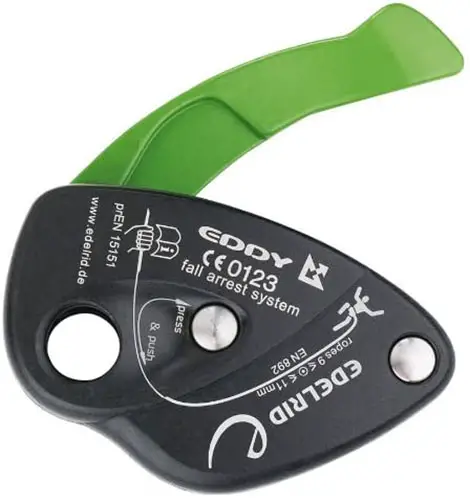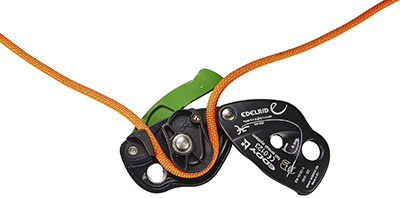Think about the kinds of climbing tools you will need to get yourself up the rocks – rope, carabiner, shoes, harness, and yours sincerely, a belay device! The peculiarity and the roles each of these tools play in making your time out there a successful one is very important. In a broader sense, your life might largely depend on them. You almost wouldn’t be able to improvise for any of them as they have been built with such integrity and functional dominance, and nothing else fits. Belay devices are somewhat irreplaceable and are equally closely synonymous with rock climbing.
And what exactly does a belay device do? A belay device is a dynamic brake system which helps to cut down speed on the climbing rope. By combining mutually with the braking hand (belayer’s quick) the rope’s tension is controlled and offers protection to the climber at the other side of the rope. The belayer’s quick works by clipping off the side of the rope that is left unattached and free. This incredible device is central to the safety of the climber on the rope.
| Name | Type | |
|---|---|---|
| Petzl Grigri Plus | Active Assisted Braking | PRICING |
| Black Diamond ATC-XP | Auto-block Tube | PRICING |
| EDELRID Mega Jul | Passive Assisted Braking With Auto-block | PRICING |
| EDELRID Eddy | Tube Style With Emergency Backup | PRICING |
Because of how wide the options are in the market, picking out the best tools for climbing can prove quite difficult. The market is filled with different varieties of belay devices and there is more to choosing the best than meets the eye. It can be really difficult to find the one that is right for you which perfectly aligns with your purpose, quality requirements and style. But now that you are here, things have never been made easier. We understand the pain points of many climbing enthusiasts who are looking to step up their climbing exercise with the right belay device. Therefore, we have created this guide to help make the best decision when buying a belay device.
Belay devices come in different categories which are depending on their structure, functionality and usage purposes.
1. Active assisted braking
Thinking about how technology has improved the space of climbing especially with belay devices, the active assisted braking types are novel belay devices to take a cue from. They are perhaps the most developed types out there. They are characterized by a distinct mode of braking which involves nipping the rope between a camming medium that’s built within it. They are designed to be functional only on a single rope thread, and this implies that they are not usable for performing rappelling.
For belayers who usually find themselves on a sole pitch sport course, this belay device type is best for them. This is largely due to the fact that this particular belay device type has a strong propensity for helping the climber achieve some amount of weight reduction by tightly clipping on the rope whenever the belayer hangs or fall off the rope. On a multiple pitch course, the active assisted braking belay device types work well in helping to bring up another belayer climber. They are great for sport and trad climbing. However, this device type has some downsides which are weight and inability to be employed for rappelling. They are usually weightier than many other device types and this is attributed to their camming mechanism which itself alone makes for the large weight.
Petzl Grigri Plus Belay Device

The Petzl Grigri is one of the best belay devices you will find out there and under the active assisted braking category. It has been improved to be more versatile and functional across more rope types.
The look is stunning and the design is sturdy, it is the type of device you can depend on when up there on the rocks. Whether you are set for sport climbing, crag climbing or even trad climbing, the Petzl Grigri has got you. It comes with a durable material build, having been crafted with aluminum side plates, with the camming system and friction plate made of stainless steel; and a buttressed nylon handle.
Talking about the compatibility of the Petzl Grigri with ropes, it is top notch! It can be used confidently on 8.5 – 11 mm dynamic single ropes and also works best on 8.9 – 10.5 mm ropes. It allows for easy maneuvering and some belay techniques involving catching falls as well as feeding slacks. Although, most active assisted braking types are generally heavy, this Petzl comes at a reduced weight and size.
It comes with a patented handle for assisted braking which works by allowing for a smooth slow release of the rope. With one hand firmly holding the rope and the other to safely unlock the cam. Altogether, this device is easy to use and features a superb securing system which makes for easy braking and release on the rope with both hands.
You almost wouldn’t need any expert to help get the device set up as it comes with engravings serving as a manual for quick and accurate installation.
 |
Pros
Cons
|
2. Auto-block tube
The Auto-block tube belay device types are probably the most common out there. In fact, it is the darling of most climbers and many belayers use them too. They are widely recognized for their versatility and incredible suitability for a wide range of climbing including gym, sport, traditional, multi-pitch, rappelling, and even single pitch. The Autoblock tube are characterized by two slots placed side by side, an extra metal loop situated on the side. The essence of the loop is to help the belayer to top-belay each second when the belay device is being set up at anchor. When a belayer top-belays with the belaying device, it is referred to as ‘reverso mode’ or simply, ‘guide’ and this gives a great edge as per auto-blocking on the rope should it happen that the climber falls.
As a word of caution in all belaying situations, even with other types of belay devices, it is essential that the brake hand remains attached to the rope. Do not forget that even the possibility of failing isn’t so much far from many brake assist devices, thus they have to be used with the right techniques.
Black Diamond ATC-XP

For many climber belayers and outdoor enthusiasts, the Black Diamond ATC-XP is most often considered a ‘do it all’ kind of belay device. In fact, if you are keen on unassisted braking, you might want to consider going for this belay device. The incredible thing about the Black Diamond is that it works doubly as a great rappel device and because of the superior ability it comes with, it is one of the best to use for multipitch climbing.
The Black Diamond provides you firm handling as you climb on as it is very lightweight and comes in a user-friendly construction. More fascinating about this device is variety of friction modes it comes with. It features a side for ‘slow’ speed for climbers who are just starting out as it generates a large amount of friction as well as provide added caution. It also comes with the ‘fast’ pace side which is a great fit for experienced belayers as it offers enough friction grooves that allows for incredible grip and stopping power.
It features a machines window which makes the device a lot lighter than most other belay devices out there, even the ATC-Guide. It is also durable having been built with hot-forged aluminum and will stay functional for long lasting period. More interesting is the fact that the device can take on a range of rope sizes from 7.7 to 11 mm and you will find it easy to perform rappelling on the device. It holds well against getting trapped or locked up in between the ropes.
 |
Pros
Cons
|
3. Passive Assisted braking with Auto-block
By ‘passive’, it means this belay device comes with no moving parts. What’s characterized by this type of belay device is that they function by a procedure that pinches the rope right in the middle of the device and the carabiner, thus helps in stopping the motion of the rope.
However, it is worthy of noting that no belay device is particularly ‘hands free’. The chief leverage that using passive assisted braking gives above others out there is their lightweight, ideal for almost all kinds of climbing and allows for rappelling on two rope strands.
EDELRID Mega Jul Belay Device

With the EDELRID Mega Jul, climbing has never been made easier. It is a heavy-duty belay device which also comes with the auto-block feature.
Built of stainless steel and aluminum, the device is ever durable and will last long. This steel construction helps to prevent immediate wear due to friction, thus prolonging the lifetime of the rope as well as the device. The parts of the device that are prone to abrasion are fortified with steel inlay. With the aluminum construction, the device weight is kept low without compromising the durability of the EDELRID Mega Jul.
It provides a high-performance braking capability which helps the belayer to achieve well-scripted falls. It also comes with a small eyelet which helps to release unit of ropes with a carabiner should you intend to bring up a climbing partner.
The EDELRID works perfectly with ropes of 7.8 to 10.5 millimeters and with its EN 15151-2 Certification, you can be sure it is a device that you can depend on.
 |
Pros
Cons
|
4. Tube Style with Emergency Backup
The Tube style with emergency backup are also a great type of belay devices and you can never go wrong with them. They are very common and are usable for different kinds of climbing. Be it gym, traditional or even rappelling, you will find this kind of belay device a great fit. Tube style belay devices are characterized by double slots though not side by side. When in use, you pass through a bent rope through one of the slots and then attach a carabiner through the to the belay loop on the harness. Because of the bent rope, friction is created against the belay device thus helping to halt the rope. Tube style belay devices have been improved over time to have grooves or teeth for added friction for halting.
When you use this kind of device for rappelling, you can pass both strands of rope through the two slots. The main perk to using the tube style is that they are very compact and are able to use a wide range of rope diameters. More so, you hardly see the ropes get caught up with tube style belay devices and they are of course seamless to use for rappelling.
EDELRID Eddy Belay Device

Looking for a tube style belay device that gives you opportunity to go big on controlling your fall speed? Go for the EDELRID Eddy. It is a very great device which comes with features that help ensue your safety on the rock side and will keep you confident as you climb up or desend.
It comes with an emergency brake mechanism which helps to achieve a well regulated and seamless descent from the rocks. The Eddy belay device comes with a wide lowering lever which is the main feature responsible for achieving controlled descents. That way, you can safely descend the rope at a speed that best fits you. As a result, it cuts out the possibility of you getting the “panic pull” syndrome.
Whether you are lead climbing or top roping, the Eddy is certain to keep you safe. It is recommended to be used with both hands but only with single ropes with diameter between 9.0 to 11.0 millimeters.
 |
Pros
Cons
|
Conclusion
Safety over aesthetics when it comes to choosing belay devices. It doesn’t matter how beautiful a belay device is if it doesn’t ensure your safety. While getting the best one you can trust can be a tedious process, our list makes it all the more fun and exciting for you. As you aim to discover new heights in your climbing experience, any of the above reviewed belay device is certain to assist you and ensure you make the best of your time out there.
You may also like:



